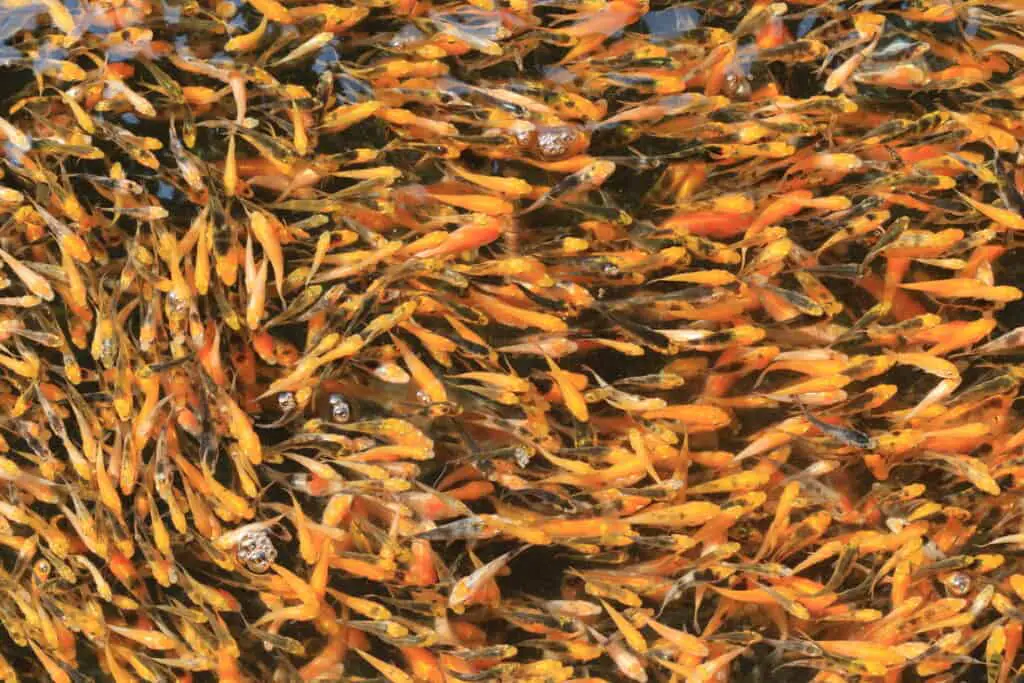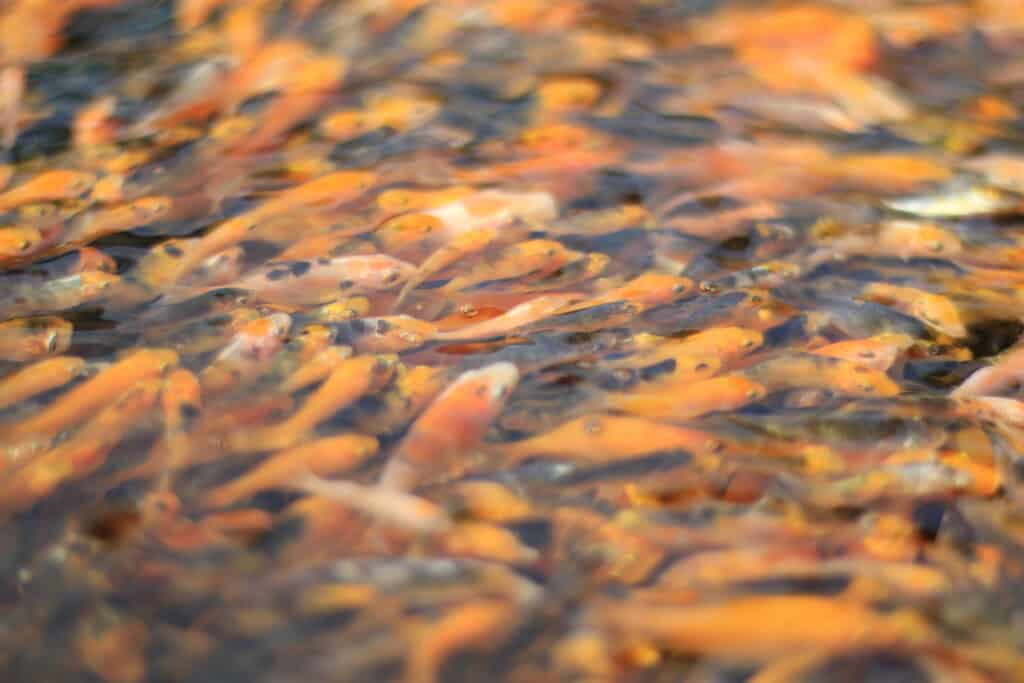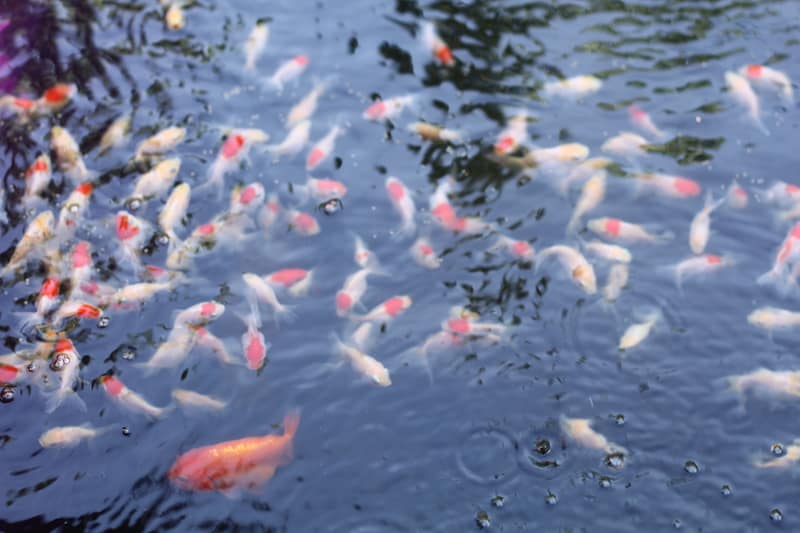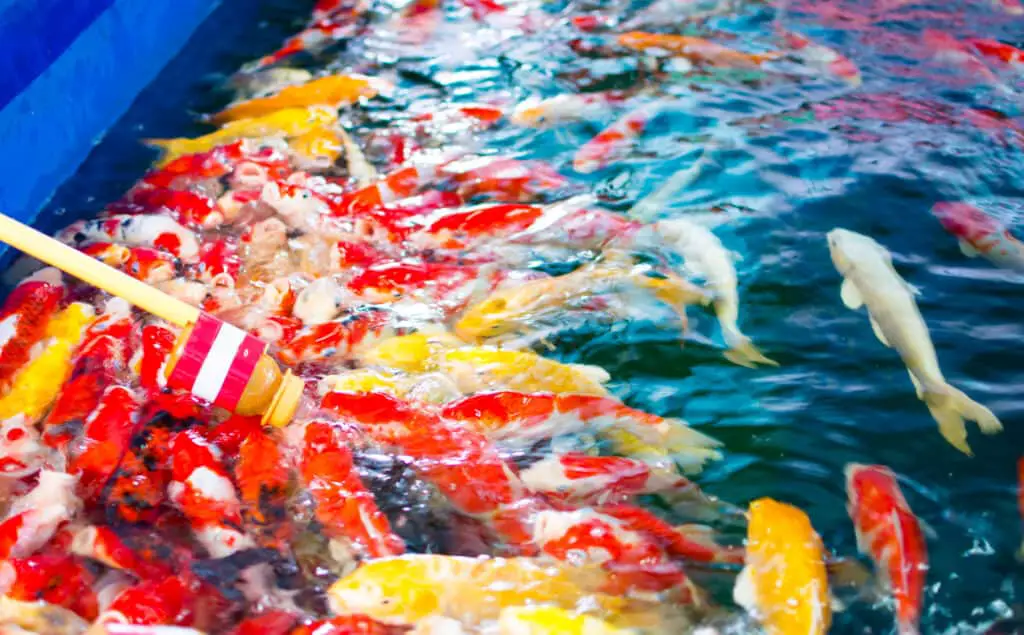
Raising Koi from birth is a wonderful experience well worth the time, effort, and money into curating the necessary care for baby fish, whether by choice or by chance. However, the spawning process is highly sensitive to its environment. It is essential to know what time of year Koi lay eggs.
In the northern hemisphere, Koi spawn between March and June, which translates to October to December in the southern hemisphere. The spring is ideal for spawning since female Koi need to be exposed to higher temperatures of no less than 16.8°C for an adequate period to ovulate and lay eggs.
Raising Koi of any age is a fascinating and enriching activity that will provide you with years of enjoyment, excitement, and anticipation. There’s something magical about watching your fish grow and thrive, thanks to your care and attention. This is especially true if you have the opportunity to raise your Koi from eggs.
Pro Tip: If you’re tired of wasting money and making costly mistakes on the koi-keeping hobby or are thinking about buying koi fish but don’t know where to start, I strongly suggest you check out this ebook. I recently read this ebook, and it contains SO much useful information, such as:
- 3 proven steps to identify koi fish diseases
- WARNING: 3 things you should NEVER do when it comes to caring for koi
- When to seek professional help when it comes to looking after your koi
What Time Of Year Do Koi Lay Eggs?

In the northern hemisphere, Koi spawn between March and June, which translates to October to December in the southern hemisphere. It is possible to naturally or artificially induce Koi spawning outside of the spring months, but a successful harvest is reduced. Immature fry is susceptible to sudden cold spells, killing them or stunting their development.
The spring is ideal for spawning since female Koi need to be exposed to higher temperatures of no less than 16.8°C for a sufficient period to ovulate and lay eggs. Furthermore, this is when Koi fish are most fertile. By that time of year, females are heavily pregnant, and males will have developed small, white bumps on their pectoral fins and gill plates to indicate they are ready to mate.
Each area will have its most appropriate breeding season onset date, determined by ambient temperature, weather patterns, and other local environmental conditions. Of course, if you breed indoors in a barn or hatchery, you can artificially adjust the environmental conditions to allow you to breed at virtually any time.
How Do You Know When Koi Are Spawning?
Often, one or more males will show more interest in a female, following her around the tank for several days before the actual day of spawning. Spawning typically begins early in the morning, with males aggressively chasing and nudging females around the pond’s shallows or edges.
Breeding is a process rather than a singular occurrence that begins long before the actual spawning. Females must consume sufficient nutrients to store them in the yolk of each individual egg. Fewer eggs will develop if this nutrient-dense food is not available.
The final stage of fertilization occurs when environmental cues such as temperature and spawning material stimulate the Koi to mate. The female then vigorously releases her eggs into the water while the males squirt sperm in the hope of finding their target. Bubbles on the pond’s surface may be a sign that your Koi have spawned.
It is important to remember that Koi mating can be abrasive, as the male will nudge the female towards the spawning mop to encourage her to lay eggs. They might even fight or nip each other. To keep your Koi safe, keep an eye on them while they’re in the mating pond and make sure the water’s deep enough to keep them from flopping out and becoming injured or even dying.
How To Tell If Koi Eggs Are Fertilized
You should carefully examine the Koi eggs to see if they are fertilized. Fertilized eggs will appear clear, with small dots resembling seeds, and soon develop into baby Koi fish. These eggs have a chance of hatching and should be stored and protected. Keep an eye on the new babies and remove the Koi from the pond to prevent them from eating or damaging the eggs.
Unfertilized eggs must be removed. They will appear fuzzy and white and should be removed as soon as possible because the unhatched and unfertilized eggs will begin to degrade and emit ammonia, which will kill the other eggs.
If unfertilized eggs are not promptly removed, they can cause overcrowding and even contribute to the spread of fungal infections or other disorders within the eggs, so be vigilant and remove them as soon as you notice them.
How Many Eggs Do Koi Lay?
A sizeable mature female can lay as many as 400,000 eggs, and as the eggs are shed, the males that follow her fertilize them right away. Koi prefer to lay their eggs in the vegetation that grows in the shallow water of ponds. You can deliver an ideal breeding habitat for them by providing plenty of plants such as hornwort, water hyacinths, water lettuce, and artificial spawning mops or ropes.
The number of Koi fish eggs that hatch is proportional to the number laid. The number of eggs laid is determined by the Koi fish’s body size and weight. When a female Koi fish lays eggs, approximately sixty percent of the eggs hatch into baby Koi.
Female Koi fish lay hundreds of thousands of eggs per kilogram of body weight. A female Koi fish weighing ten kilograms can lay up to one million eggs. The number of eggs laid by female Koi fish can vary; it can be greater or less than the stated figure.
How To Care For Koi Eggs and Fry

If you’ve been breeding Koi fish and have successfully gotten your female to lay eggs, or if you happen to find your Koi fish laying eggs, it is essential to know how to care for them. Some people may not want their Koi fish to mate and have offspring. After all, raising fish fry can be costly, time-consuming, and challenging. Aside from that, caring for Koi fish can be very fulfilling.
If you want to care for the eggs and raise the fry, you must remove them from the main tank. If the eggs are not removed, the adult Koi fish will likely eat most or all of them. Adult Koi fish appear to be more interested in eating fish fry after they hatch than in eating them when they are embryonic; however, you should try to collect the eggs before they hatch.
Investing in a spawning rope is essential if you wish to breed Koi. Female Koi fish will lay their eggs along these spawning ropes, to which the eggs adhere. A spawning rope makes it easier to safely remove your unhatched eggs from the main tank.
Remember that not all Koi fish are viable. Eggs that are translucent and slightly brown are fine, but milky and white eggs are not. These will either not hatch or hatch with congenital disabilities, rendering the Koi fish fry incapable of long-term survival.
Now that the eggs have been transferred to an incubation or nursery pond, you must ensure optimal water conditions for proper Koi fish egg development and hatching. If you have a spawning rope with many Koi fish eggs on it, you should use a 100-gallon aquarium and make sure the top of the spawning rope is no more than 2 inches below the water’s surface.
In terms of water temperature, it should be between 68- and 71-degrees Fahrenheit. Temperatures outside this range cause most eggs not to hatch or be born with congenital disabilities. Keeping the water’s pH and hardness at a medium level is sufficient. Although neutral water works well, a pH level of around 7.5, or slightly basic, is preferable for their survival.
The Koi fish eggs require oxygen, which you can provide with a simple air stone or two. If everything goes as planned, the Koi fish eggs should hatch in four or five days. The Koi fry immune systems are not fully developed, making them vulnerable to stress and disease. Ideally, you want a filter that has a high level of mechanical, chemical, and biological filtration capacity.
The other crucial aspect is feeding. Koi fish fry will be sustained for the first few days by the egg yolk they ate while still in the eggs. However, after the first three days, you must begin feeding them yourself. Some people use real egg yolks because the nutrients in egg yolks are ideal for Koi fish fry.
You can, however, go out and buy specialized Koi fish fry food. Because their mouths are so small, feeding them anything substantial for the first three or four weeks will not work. You can start feeding them solid foods once their mouths have grown bigger.
How To Get Rid Of Koi Eggs
Breeding Koi can be an expensive exercise and incredibly taxing on your filtration system. Although Koi feast on their eggs, spawning produces thousands of eggs that hatch in a few days if fertilized. This makes it impossible to depend on adult Koi for ridding your tank of eggs.
A once-off treatment of potassium permanganate is effective at killing Koi eggs. While leaving your filter functioning, mix one-part-per-million of potassium permanganate into solution and distribute it evenly around your tank. After two hours, add hydrogen peroxide or sodium thiosulfate to the tank to act as a neutralizer.
This will rid your tank of eggs, but it will also leave the water sparkling and your mature Koi unaffected. When handling these chemicals, you must take the necessary safety precautions by wearing protective gloves and safety glasses. Furthermore, a dose of one part per million is safe for frogs, plants, birds, and most importantly, your Koi. It is imperative that you correctly calculate the concentration needed for your pond.
How Fast Do Immature Koi Grow?

For the most part, Koi fish will continue to grow until they die. It will take between four and five years to mature a Koi fish and then another four years to reach champion Koi size. As a result, you can expect Koi to reach full size in about ten years, though they will continue to grow as they age steadily, but not much.
The genetics of the Koi play a significant role in determining how large the fish will be. If a specific Koi does not possess the required predetermined traits, it will simply not grow into a large specimen – regardless of how ideal the pond environment may be.
Because of genetic predispositions, most Koi will reach a size of 20 inches if adequately cared for and kept in the right environment. Under ideal conditions, the average Koi will grow to between 6 and 8 inches by the end of its first year.
What Can You Do To Increase How Large Koi Grow?
If you want to raise larger Koi, you should use a young female that has a large head and backbone to breed. Of course, knowing the fish’s lineage will give you an advantage. Therefore, it is essential to do careful research when purchasing Koi from a breeder to be familiar with the genetics of the fish in which you are investing.
Furthermore, the diet has a significant impact on the growth potential of Koi carp and should be carefully considered. Two of the most important things to remember are that fish are grazers and that if they are fed too much, much of it is wasted. Saki-Hikari, a high protein feed, should be given in small amounts five or six times per day.
Another factor to consider is the hormones released into the water by Koi carp. When the concentration of these hormones reaches a critical level, the Koi stop growing, and egg production ceases. This is how they keep a natural balance in the wild and avoid overpopulation.
Low fish numbers in your pond and good water quality will go a long way toward promoting growth in your Koi carp. In terms of water volume, 250 gallons per Koi is ideal. Maintaining good water quality and adhering to this ratio will increase your chances of achieving impressive growth.
Most keepers keep their Koi in outdoor ponds, which are preferable to indoor aquariums for various reasons, including the natural day/night cycles and the feeding opportunities provided by insects.
Conclusion
Spawning occurs in the Spring when elevated temperatures allow female Koi to ovulate and lay eggs. This happens between March and June in the northern hemisphere, which translates to October to December in the southern hemisphere. Furthermore, this time of year is safer for Koi eggs and fry, which are susceptible to colder temperatures, stunting their development and even causing death.


